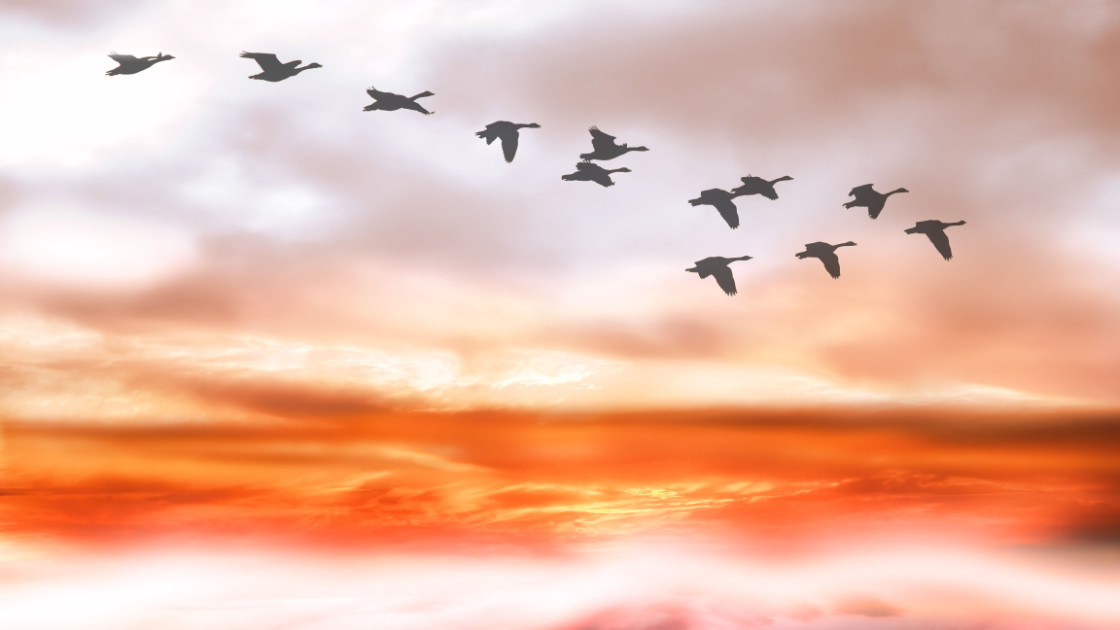The Birds!
Hello Folks, Aunt Eunice here. I am in fine fettle now that spring has arrived and I hope you are too. Many signs of spring are all around as I am sure you’ve noticed. Daylight Savings Time means it’s light enough when I get home from the farm, seeing the crocuses bloom and the pussy willows budding. For the last two weeks, being around our house has been like being in the Alfred Hitchcock movie “The Birds”. Hundreds and thousands of starlings have migrated north and I swear, all of them are perched in my trees! The racket they make is quite loud. Sometimes they take off all at once for no apparent reason and swoop and swirl in unison like the beginning of a murmuration. It is a sight to behold!
Snow Geese Formation Spotted
Another migratory species, snow geese, passed over our house a number of weeks ago. In all the years I have lived there, I have never been at the right place at the right time to observe them. What a sight to see! The sun was lowering in the west and the geese were so high up, the late day rays made them look like twinkle lights or strands of silver beads. The honking they emitted during flight was different than the Canadian geese that had flown over earlier that day. That was why I looked up and saw them. What a beautiful thing. As they flew overhead, I saw a jet leaving a contrail behind it and couldn’t help, but think “you have it easy” with powerful engines carrying you along. The bird species has its heart, wings and some mysterious directional sense to make a journey that could be thousands of miles in length. Below is some information about bird migration from allaboutbirds.org.
Bird Migratory Observations
Geese winging their way south in wrinkled V-shaped flocks is perhaps the classic picture of migration—the annual, large-scale movement of birds between their breeding (summer) homes and their non-breeding (winter) grounds. Of the more than 650 species of North American breeding birds, more than half are migratory. Birds that nest in the Northern Hemisphere tend to migrate northward in the spring to take advantage of burgeoning insect populations, budding plants and an abundance of nesting locations. As winter approaches and the availability of insects and other food drops, the birds move south again. Escaping the cold is a motivating factor but many species, including hummingbirds, can withstand freezing temperatures as long as an adequate supply of food is available. The two primary resources being sought are food and nesting locations.
Origins of long-distance migration
While short-distance migration probably developed from a fairly simple search for food, the origins of long-distance migration patterns are much more complex. They’ve evolved over thousands of years and are controlled at least partially by the genetic makeup of the birds. They also incorporate responses to weather, geography, food sources, day length, and other factors.
For birds that winter in the tropics, it seems strange to imagine leaving home and embarking on a migration north. Why make such an arduous trip north in spring? One idea is that through many generations, the tropical ancestors of these birds dispersed from their tropical breeding sites northward. The seasonal abundance of insect food and greater day length allowed them to raise more young (4–6 on average) than their stay-at-home tropical relatives (2–3 on average). As their breeding zones moved north during periods of glacial retreat, the birds continued to return to their tropical homes as winter weather and declining food supplies made life more difficult. Supporting this theory is the fact that most North American vireos, flycatchers, tanagers, warblers, orioles, and swallows have evolved from forms that originated in the tropics.
Taking a journey that can stretch to a round-trip distance of several thousand miles is a dangerous and arduous undertaking. It is an effort that tests both the birds’ physical and mental capabilities. The physical stress of the trip, lack of adequate food supplies along the way, bad weather, and increased exposure to predators all add to the hazards of the journey.
Migrating birds can cover thousands of miles in their annual travels, often traveling the same course year after year with little deviation. First-year birds often make their very first migration on their own. Somehow they can find their winter home despite never having seen it before, and return the following spring to where they were born. The secrets of their amazing navigational skills aren’t fully understood, partly because birds combine several different types of senses when they navigate. Birds can get compass information from the sun, the stars, and by sensing the earth’s magnetic field. They also get information from the position of the setting sun and from landmarks seen during the day. There’s even evidence that sense of smell plays a role, at least for homing pigeons.
Find out more at The Cornell Lab
What an amazing thing for birds to accomplish. Migration. Well, I am happy to be migrating into spring, my favorite time of year. I seem to awaken in spring like a bear coming out of hibernation. Watch for the subtle greening of the brush and the grass and the trees. It’s lovely to see the various shades of green develop as the next two to three months progress. That’s all for now. Stay safe. Take care and talk to you soon. Aunt Eunice
